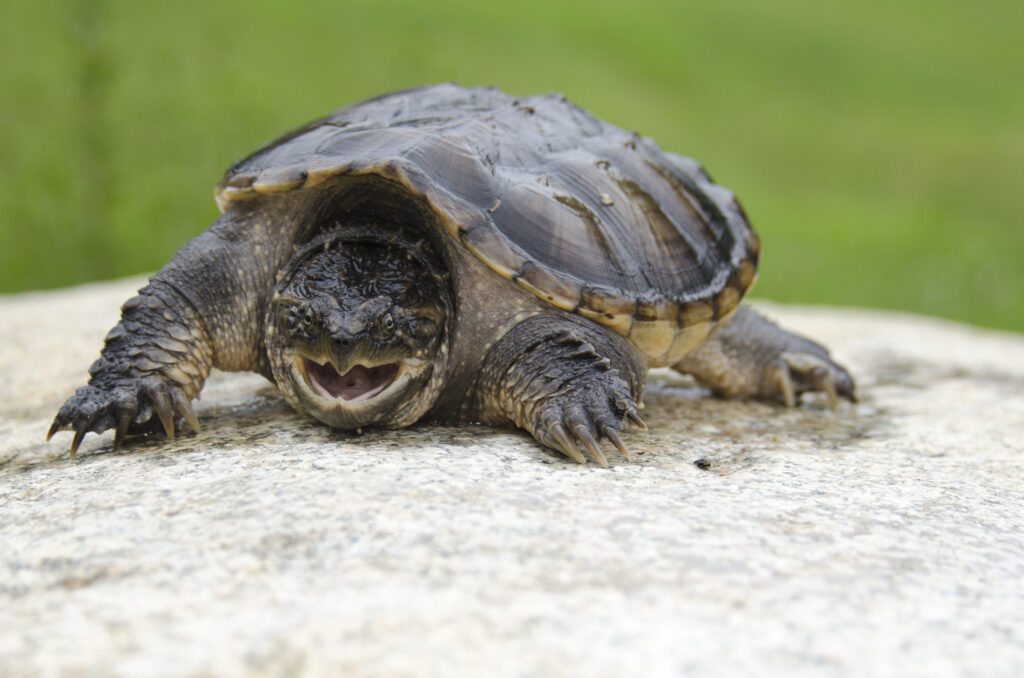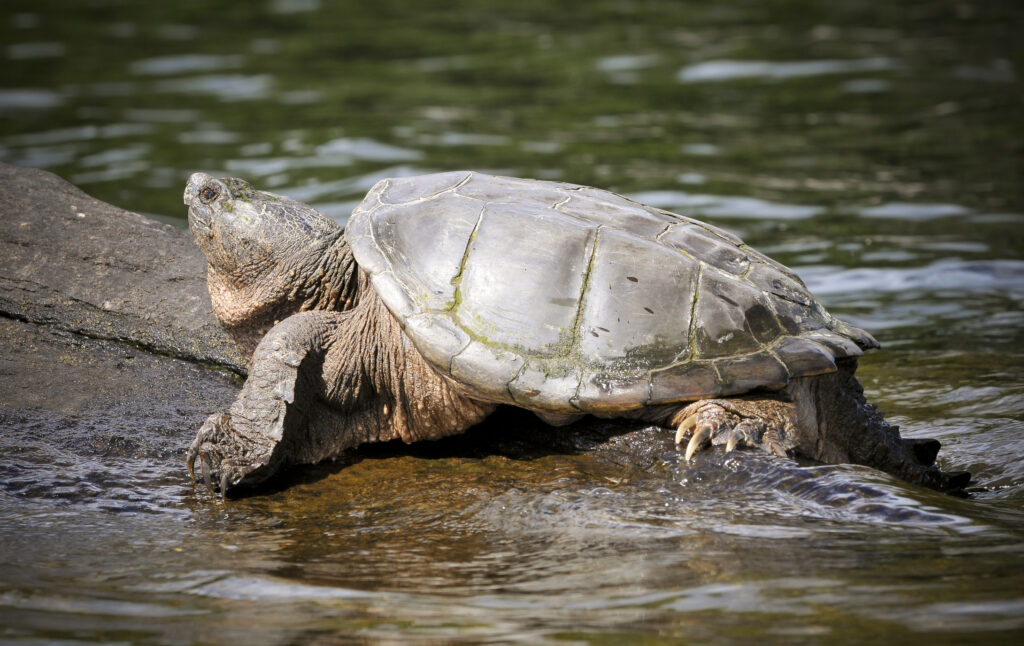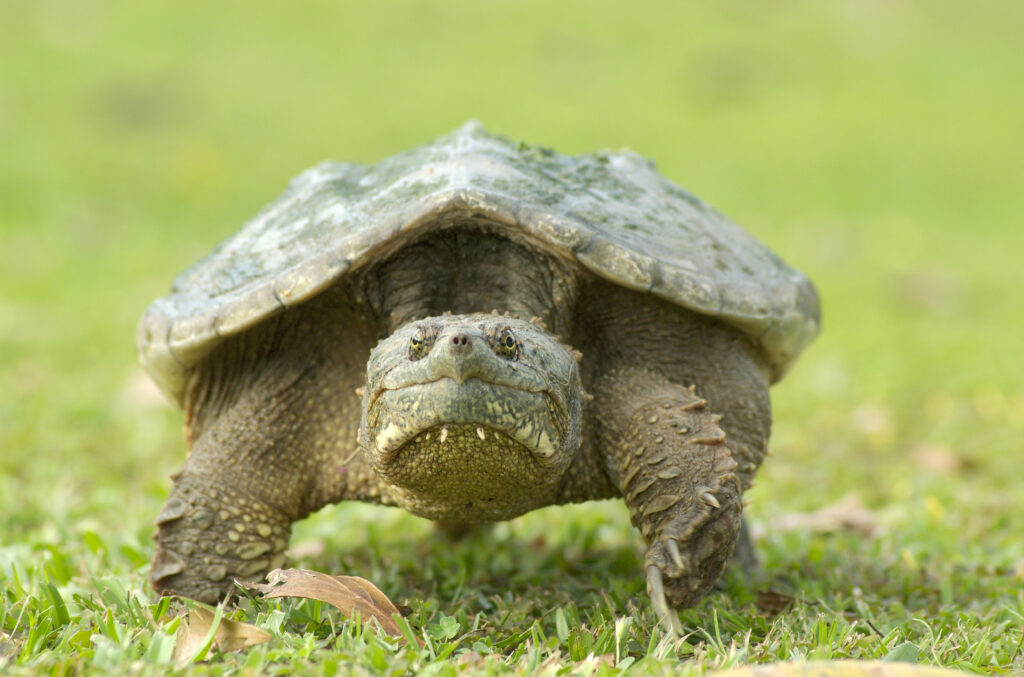The animal kingdom is home to a wealth of fascinating creatures, some of which have been around for millions of years. Turtles, for example, are thought to have originated over 200 million years ago. While some of the turtle species have become extinct during that time, there are many species still alive, including one of the most interesting – the snapping turtle.
Here we’ll learn more about the snapping turtle, how to recognise them, where they live and where you can find them right here at Blue Reef Portsmouth!
What are snapping turtles?
The snapping turtle is part of the Chelydridae family, which has only two living species left out of its original 9. These extant species are the common snapping turtle (Chelydra serpentina) and the alligator snapping turtle (Macrochelys temminckii).
Both of these turtles are freshwater creatures, and they get their name quite literally from their tendency to snap or bite! We’ll find out more about that next…
Why do snapping turtles snap?
Many species of turtles are able to retract fully into their shells when they need to defend themselves. They do this by pulling back their necks into the shells – and some, like the mud turtle, can even retract its limbs too!
However, there are some turtles that can’t do this, like the snapping turtle. With that in mind, they developed a different way of defending themselves, by snapping or biting at potential predators to warn them off. They may not have teeth, but their strong jaws do the job just fine when necessary!

What do snapping turtles look like?
Snapping turtles have a shell just like all others, called a carapace. They also have a tail which can be as long as the shell, with sharp ridges running along it. The male’s tail is usually longer and thicker than the female’s. Both species of snapping turtle typically have a yellowish neck, legs and tail while the head is dark, and the shell is usually somewhere between tan and black in colour.
The alligator snapping turtle however has a much more armoured shell, with pointed ridges that make it look a little more prehistoric. This is the largest of the freshwater turtles, with males weighing up to 70-80kg.
Snapping turtles also have long claws, just like most other turtles.
Where do snapping turtles live?
You’ll only find snapping turtles in the wild in North America – although you can see one right here at Blue Reef Portsmouth too! Typically snapping turtles live across southern Canada right through eastern and central America, down to Florida.
Common snapping turtles favour the likes of rivers, lakes, marshes and even shallow ponds and they can tolerate brackish water which is a mix between fresh and sea water. However, an alligator snapping turtle is more likely to be found in a more exclusive freshwater habitat.

What do they eat?
Snapping turtles are omnivores, which means they will eat almost anything! Their prey includes aquatic plants like algae and moss, fish, smaller turtles and frogs, birds like mallards and invertebrates like insects and crayfish.
This species are nocturnal and will hunt for their food at night. They patrol the floor of the stream or lake they call home, and typically use ambush tactics by burying themselves and waiting for their prey to come along. Interestingly, their tongue resembles a worm, which is great for luring any unsuspecting prey closer!
Lifecycle of a snapping turtle
The average lifespan of a snapping turtle is around 30-50 years old in the wild. The female will lay eggs – anywhere from 25 to 80 of them – and covers them with sand for incubating as well as protection. The length of incubation time can depend on the temperature, but typically it can be anywhere from 9-18 weeks.
The hatchlings are only around an inch long when they come out of their shell, but they reach maturity in around 4-7 years, when they are considered an adult.
Factors like predators will affect their potential lifespan. Young snapping turtles are vulnerable to the likes of foxes, coyotes, raccoons and birds like herons, hawks and owls. Adult snapping turtles have fewer predators thanks to their size.

More interesting facts
Want to know even more fascinating information about snapping turtles?
- They can go months without breathing. Yes that’s right – snapping turtles will usually go into hibernation in the winter and instead use other ways of absorbing oxygen in order to stay alive.
- Snapping turtles can sing. A snapping turtle can make a whole host of noises, including whistling, barking, growling and even chirping. But did you know that they can also make sounds as if they’re singing?
- Alligator snapping turtles may be able to live up to 150 years. Reports from the 1970s showed that some alligator snapping turtles were found with musket balls and flint arrows in their shells, indicating that they might be able to live for a lot longer than we thought!
- Despite their name, they’re quite passive. Snapping turtles will typically only defend themselves if provoked or threatened, and won’t actively attack you. In fact, they’re known to be quite passive, especially in the water.
So, if you fancy putting your knowledge to the test, book your tickets today to come and see our very own snapping turtle at our Freshwater Fun exhibit!
